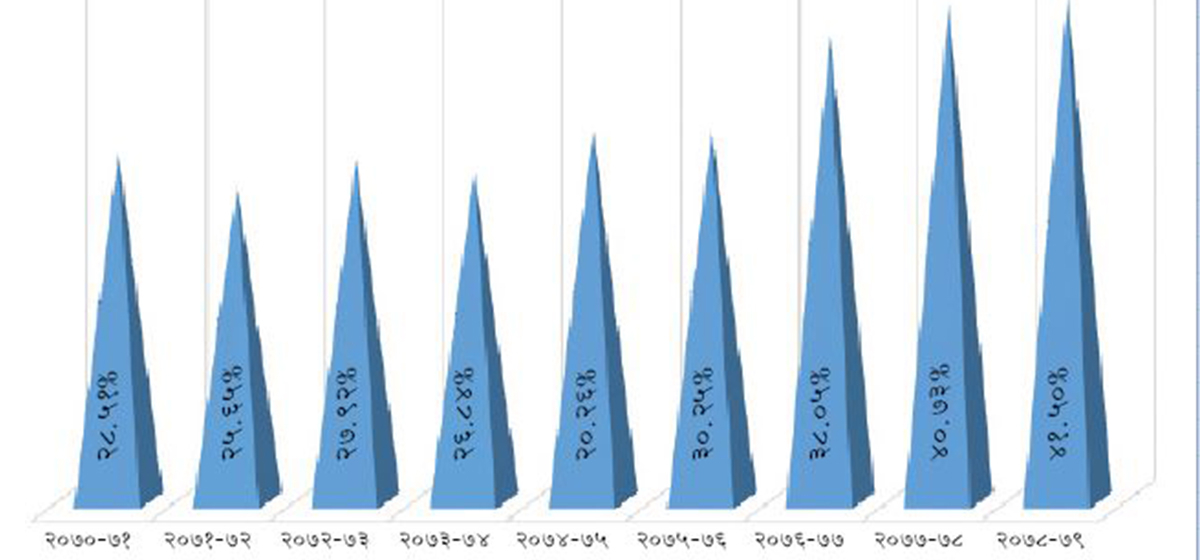
OR
Nepal has public debt of over Rs 2 trillion
Published On: March 7, 2023 06:15 PM NPT By: Dilip Paudel

KATHMANDU, March 7 :The country's public debt is increasing every year. By mid-February of the current fiscal year (FY 2022/23), the debt liability of the government has reached about Rs 2 trillion. Experts have said that the country's economy has become more challenging due to the increasing debt obligations.
Public debt has increased by about Rs 32 billion during the seven months since June. According to the Public Debt Management Office, the debt of the government has increased to Rs 2.0433 trillion by the end of mid-February. It has internal debt of Rs 996 billion and foreign debt of Rs 1.0473 trillion. Until last fiscal year, the debt was Rs 2.0133 trillion. Dilaram Giri, information officer of the Public Debt Management Office, said that the debt has increased due to the increase in interest rates and devaluation of the Nepali currency.
“The government took a lot of debt for reconstruction,” Giri said, “The debt seems to have increased in the last few years.”
Since the government is unable to increase revenue collection, it has been making the budget by considering foreign and domestic loans as major sources. As the source of revenue is decreasing with the increase in the size of budget, the volume of debt is also increasing. There is a compulsion to proceed with big infrastructure construction projects for the development of the country. Loan should be taken for those schemes when the internal resources are insufficient. Therefore, the country is burdened with debt.
Public debt has almost doubled in five years. In the fiscal year 2018/19, public debt was Rs 1.048 trillion. The debt reached Rs 1.4334 trillion in FY 2019/20, Rs 1.7378 trillion in FY 2020/21 and Rs 2.013 trillion in FY 2021/22. In the year 2022/23, the external debt of the country has reached 41.50 percent of the Gross Domestic Product (GDP). The size of Nepal's GDP is equal to Rs 4.85162 trillion.
Along with the increase in the size of the country's GDP, the size of internal and external debt has also increased. In the year 2017/18, the country’s external debt was equivalent to 30.26 percent of the GDP.
External debt was 40.73 percent of the GDP in FY 2020/21.
The government has collected Rs 554 billion in revenue as of March 5 in the current fiscal year while the government expenditure stands at Rs 748.5 billion. The revenue collected is about Rs 200 billion less than the expenditure.
As the revenue collection does not cover the government expenditure, the government has to take internal and external loans.
Experts say that as the burden of public debt increases, more challenges will be added to the country's economy. But the officials of the Public Debt Management Office say that the debt can be sustained up to 53 percent of the GDP.
"There is no need to panic at the moment that there is a lot of debt," said Giri, the information officer, “Increasing debt but not increasing revenue is a matter of concern.” He said that due to the increase in public debt and decrease in revenue, there is pressure on the economy. Dr Gopal Prasad Bhatt had published a research paper arguing that the public debt should be 33 percent of the GDP.
The government had paid Rs 117.42 billion as the principal and interest of public debt in the last fiscal year (FY 2021/22). Of this amount, Rs 72.80 billion was paid as the principal amount and Rs 44.61 billion as interest. A penalty of Rs 41 million was also paid for non-payment of principal and interest within the deadline.
Public debt is justified if it contributes positively to the expansion of the size of the country’s GDP. Currently, the government is struggling to meet the current expenses due to a decline in revenue collection.
When the government prepares the budget, it sets the target for revenue collection, foreign aid, internal and external debt. The estimated budget for the repayment of loan and interest is also allocated.
When the government prepared the budget for the current fiscal year, it had set a target of collecting 69.13 percent revenue in addition to raising 14.27 percent domestic debt, 13.50 percent foreign loan and receiving 3 percent foreign grant. This shows that 27.77 percent of the total budget of the government is internal and external debt. Through the half-yearly review, the government has revised the estimates and downsized the budget to Rs 1.55 trillion for the current year. It is estimated that Rs 1.341 trillion will be spent from revenue and internal debt, Rs 38.4583 billion from foreign grants and Rs 0.17 trillion towards foreign loans.
The government raises internal debt through Nepal Rastra Bank (NRB), while external debt is taken from foreign agencies. The government raises loans through NRB using various instruments. NRB raises internal loans through development bonds, savings bonds and treasury bills. The government has to buy bonds at high interest rates. Because the interest rate of the bank is expensive, it is compelled to fix a high interest rate because it will not be sold unless it is issued at a high price. The government has been taking loans from foreign agencies at subsidized rates. External loans have a maturity period from 12 to 40 years. Interest on foreign loans ranges from a minimum of 0.75 percent to a maximum of 3 percent. Nepal may not get concessional loans if it is upgraded from a least developed country. Then a situation may arise where high interest has to be paid.
Nepal has taken huge loans from the International Monetary Fund, World Bank, Asian Development Bank and other agencies. Similarly, it has taken loans from Japan International Cooperation Agency (JICA), EXIM Bank’s Line of Credit-India, EXIM Bank of China, International Fund for Agricultural Development (IFAD), OPEC Fund for International Development (OFID), European Investment Bank (EIB), EXIM Bank Korea, Saudi funds and others. The government has the facility to pay its debt in US Dollar, Japanese Yen, Euro, Pound Sterling and Chinese Yen, which are recognized as Special Drawing Rights by the International Monetary Fund (IMF).
You May Like This

Can Nepal Avoid the Debt Trap?
Many of the so-called ‘projects of national pride’ are being executed through foreign assistance with considerable loan amounts. All these... Read More...

NAC clears almost four billion rupees debt in one year
KATHMANDU, July 20: Nepal Airlines Corporation (NAC) has paid off a substantial debt of almost four billion rupees, including interest... Read More...

The global economy
Will recent growth spurt continue over the next few years? Or is the world experiencing a temporary cyclical upswing? ... Read More...










Just In
- NRB introduces cautiously flexible measures to address ongoing slowdown in various economic sectors
- Forced Covid-19 cremations: is it too late for redemption?
- NRB to provide collateral-free loans to foreign employment seekers
- NEB to publish Grade 12 results next week
- Body handover begins; Relatives remain dissatisfied with insurance, compensation amount
- NC defers its plan to join Koshi govt
- NRB to review microfinance loan interest rate
- 134 dead in floods and landslides since onset of monsoon this year








Leave A Comment